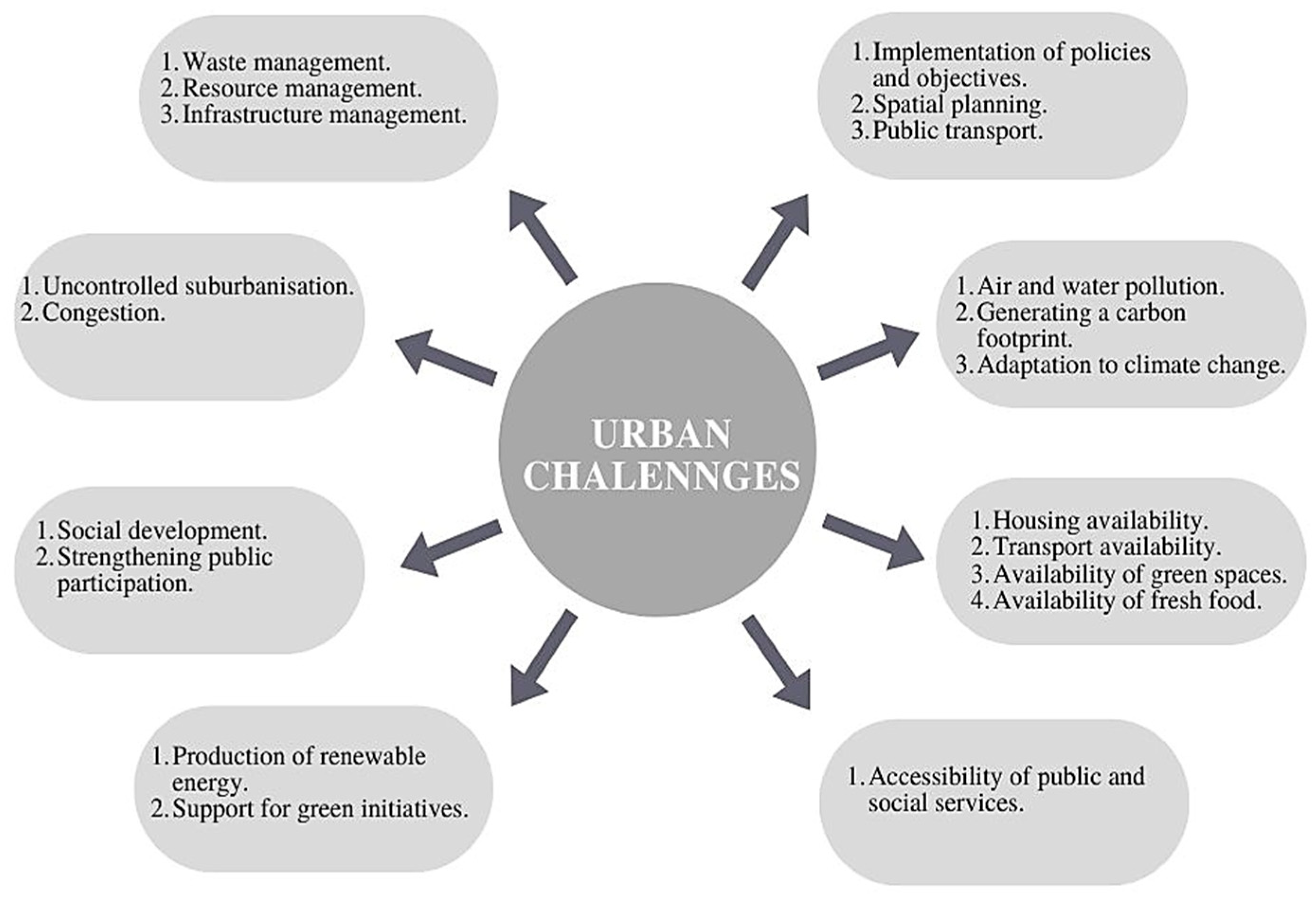Mobility-as-a-Service as a Catalyst for Urban Transport Integration in Conditions of Uncertainty
Abstract
1. Introduction
2. Literature Review
2.1. Challenges and Developments in Urban Transportation
2.2. The Importance of Transport Integration for Urban Mobility
2.3. Mobility as a Service as a Final Stage in Urban Transport Integration
3. Materials and Methods
3.1. Research Framework
- Presentation of the main characteristics of the Tri-City agglomeration (see Section 3.2).
- Data collection to analyse MaaS users (see Section 3.3).
- Results (see Section 4).
- Discussion and recommendations (see Section 5).
3.2. Case Study
3.3. Data Collection
3.4. Data Analysis
4. Results
4.1. Descriptive Statistics
4.2. Results for the Ordered Logit Model
- (1)
- In terms of the intensity of travelling:
- The more frequently the person is travelling, the more intense he or she uses MaaS applications to choose the optimal option to travel but the optimal one does not mean the cheapest one or the fastest one;
- If the journeys are taken only during workdays or only during the weekend, then the traveller uses MaaS applications significantly less often;
- (2)
- In terms of car-related mobility choices:
- If someone is travelling by his or her own car to carry out shopping, then he or she uses the MaaS applications significantly less frequently;
- If someone does not own a car, then he or she uses the MaaS applications significantly less often;
- (3)
- In terms of using PT (bus, tram, trolley bus, rapid urban rail, or regional rail) or environmentally friendly modes of transport (bike or by foot):
- If the traveller is using PT or a bike or goes by foot to their final destination, then he or she uses MaaS applications significantly less frequently;
- (4)
- In terms of the socio-economic situation:
- If the traveller is male, he uses MaaS applications more often;
- Older users usually use MaaS applications more often than youngest ones;
- The higher the education level of the respondent, the lower the intensity of using MaaS applications;
- Regular workers use MaaS applications significantly less often (probably because of the high level of knowledge of the possible routes from their point of origin to their point of destination).
5. Discussion
- Seamless information;
- Seamless time (reduced waiting times);
- Seamless space (short distances between modes);
- Seamless service.
- Insufficient accessibility of travel and traffic data—without access to a full range of datasets across Europe from public and private sources, services will remain limited in scope.
- A lack of travel and traffic data interoperability—the ability to easily exchange and integrate multiple data sources of different transport modes is essential.
- A lack of travel information service interoperability—many travel/transport information services exist at city, regional, and national levels. However, the interoperability between such services remains limited.
- Insufficient travel and traffic data quality—the quality of travel and traffic data in terms of being accurate, up to date, etc., are fundamental for the widespread uptake of multimodal travel information services.
- Implement free public transport.
- Adjust the transport offer to the needs of people with disabilities.
- Build an integrated transport hub near the railway/tram/bus station.
- Implement a metropolitan bike system (available at bus stops and stations and on platforms).
- Popularisation of ITS.
- Introducing a dynamic passenger information system.
- Introducing metropolitan tickets.
- Expansion of the metropolitan railway.
- Common unified standards of static passenger information.
- Appropriate methods of sharing data in a way that is fair to consumers and businesses to increase opportunities for integrating into a MaaS platform;
- Support business and industry in elaborating interoperability standards for facilitating communication between mobility systems;
- Support—in collaboration with national authorities—innovation and MaaS development by incorporating the notion that no transportation title is anonymous;
- Address the physical infrastructure challenge by working with the car- and bike-sharing providers and other mobility service operators/providers to deliver adequate infrastructure;
- Address the physical infrastructure challenge by working with the car- and bike-sharing providers and other mobility service operators/providers to deliver adequate infrastructure for car-sharing, bike-sharing, and adequate cycling lanes for safe bike riding;
- Support and become a member of a MaaS partnership model and help to establish a level-playing field for the mobility service operators/providers;
- Orchestrate MaaS as a member of the MaaS partnership towards high-level objectives such as decreasing the impact of transport and mobility on the environment and human health;
- Support transport infrastructure providers (TIPs) to apply integrated network management and assist the coordination between TIPs for different modes and between them and other partners such as MaaS providers and mobility service operators/providers;
- Provide—in collaboration with national authorities—platforms for knowledge exchange for integrated network management.
6. Conclusions
Author Contributions
Funding
Institutional Review Board Statement
Informed Consent Statement
Data Availability Statement
Conflicts of Interest
Appendix A
| Variable | Degrees of Freedom | Log. Likelihood | Chi-Sq. | p-Value |
|---|---|---|---|---|
| Const | 5 | −719.157 | ||
| Frequency of travel | 1 | −715.553 | 7.20884 | 0.007255 |
| Days when travelling | 1 | −703.924 | 23.25885 | 0.000001 |
| Using car (work/school) | 1 | −703.897 | 0.05384 | 0.816508 |
| Using car (shopping) | 1 | −703.515 | 0.76348 | 0.382243 |
| Using car (administration) | 1 | −703.405 | 0.21931 | 0.639568 |
| Using car (medical visits) | 1 | −703.243 | 0.32527 | 0.56846 |
| Using car (recreation/entertainment) | 1 | −702.948 | 0.59011 | 0.442377 |
| Not having own car | 1 | −694.547 | 16.80158 | 0.000041 |
| Renting a car (recreation) | 1 | −693.271 | 2.55253 | 0.110117 |
| Car-sharing (recreation) | 1 | −693.081 | 0.37993 | 0.537642 |
| PT (tram, bus…) work/school | 1 | −691.789 | 2.58342 | 0.107988 |
| PT (tram, bus…) shopping | 1 | −689.726 | 4.12536 | 0.042245 |
| PT (tram, bus…) administration | 1 | −682.551 | 14.35049 | 0.000152 |
| PT (tram, bus…) medical visits | 1 | −681.917 | 1.26721 | 0.26029 |
| PT (tram, bus…) recreation | 1 | −674.31 | 15.2142 | 0.000096 |
| PT (rapid rail) work/school | 1 | −668.327 | 11.96641 | 0.000542 |
| PT (rapid rail) shopping | 1 | −667.936 | 0.78297 | 0.376233 |
| Train (SKM, Regio, and PKM) administration | 1 | −663.71 | 8.45017 | 0.00365 |
| PT (rapid rail) medical visits | 1 | −660.898 | 5.62548 | 0.017701 |
| PT (rapid rail) recreation | 1 | −660.783 | 0.22969 | 0.631754 |
| Own bike (work/school) | 1 | −659.388 | 2.7895 | 0.094884 |
| Own bike (shopping) | 1 | −656.943 | 4.88936 | 0.027023 |
| Own bike (administration) | 1 | −655.151 | 3.5841 | 0.058335 |
| Own bike (medical visit) | 1 | −654.355 | 1.59192 | 0.207052 |
| Own bike (recreation) | 1 | −653.508 | 1.69507 | 0.192934 |
| Shared bike (recreation) | 1 | −653.263 | 0.48933 | 0.484226 |
| Own motorbike/scooter (recreation) | 1 | −653.004 | 0.51901 | 0.471266 |
| Own e-scooter (work/school) | 1 | −652.75 | 0.5075 | 0.476225 |
| Own e-scooter (recreation) | 1 | −652.734 | 0.03241 | 0.85713 |
| Shared e-scooter (work/school) | 1 | −652.134 | 1.20042 | 0.273238 |
| Shared e-scooter (recreation) | 1 | −651.778 | 0.71078 | 0.399185 |
| On foot (work/school) | 1 | −651.578 | 0.40091 | 0.526617 |
| On foot (shopping) | 1 | −651.498 | 0.15931 | 0.689789 |
| On foot (administration) | 1 | −649.934 | 3.12855 | 0.076932 |
| On foot (medical visit) | 1 | −648.564 | 2.73872 | 0.097943 |
| On foot (recreation) | 1 | −648.455 | 0.21933 | 0.639553 |
| Using multiple transport modes while travelling | 1 | −648.296 | 0.31816 | 0.572716 |
| Assessment of PT operation in Tri-City | 1 | −648.295 | 0.00082 | 0.977161 |
| Frequency of using PT | 1 | −648.126 | 0.33839 | 0.560758 |
| Gender | 1 | −646.882 | 2.48865 | 0.11467 |
| Age | 1 | −634.138 | 25.48788 | 0.00000 |
| Education | 1 | −631.279 | 5.71847 | 0.016787 |
| Socio-economic status | 1 | −628.525 | 5.5077 | 0.018933 |
| Variable | Degrees of Freedom | Wald Stat | p-Value |
|---|---|---|---|
| Const | 5 | 556.4074 | 0 |
| Frequency of travel | 1 | 4.9592 | 0.025952 |
| Days of travelling | 1 | 4.0423 | 0.044373 |
| Lack of own car | 1 | 8.0624 | 0.004519 |
| Using car (shopping) | 1 | 13.3116 | 0.000264 |
| Using PT (bus, tram) administration | 1 | 4.304 | 0.038024 |
| Using PT (bus, tram) recreation | 1 | 11.3474 | 0.000756 |
| Using PT (rapid rail) medical visits | 1 | 9.2428 | 0.002364 |
| Own bike (administration) | 1 | 7.602 | 0.00583 |
| On foot (administration) | 1 | 8.0632 | 0.004517 |
| Gender | 1 | 4.6084 | 0.031816 |
| Age | 1 | 30.0445 | 0 |
| Education | 1 | 3.4859 | 0.061893 |
| Socio-economic status | 1 | 4.4676 | 0.034543 |
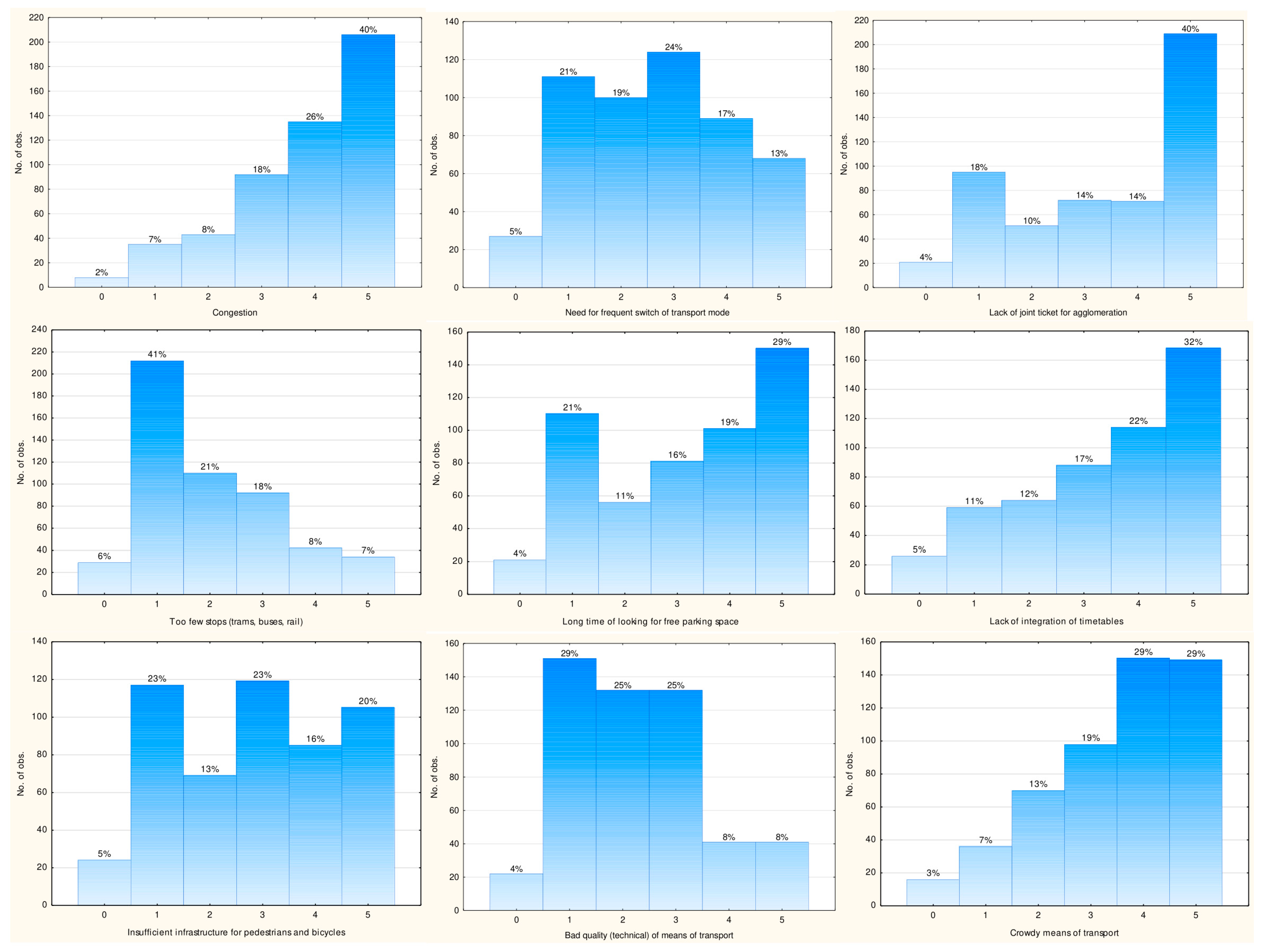

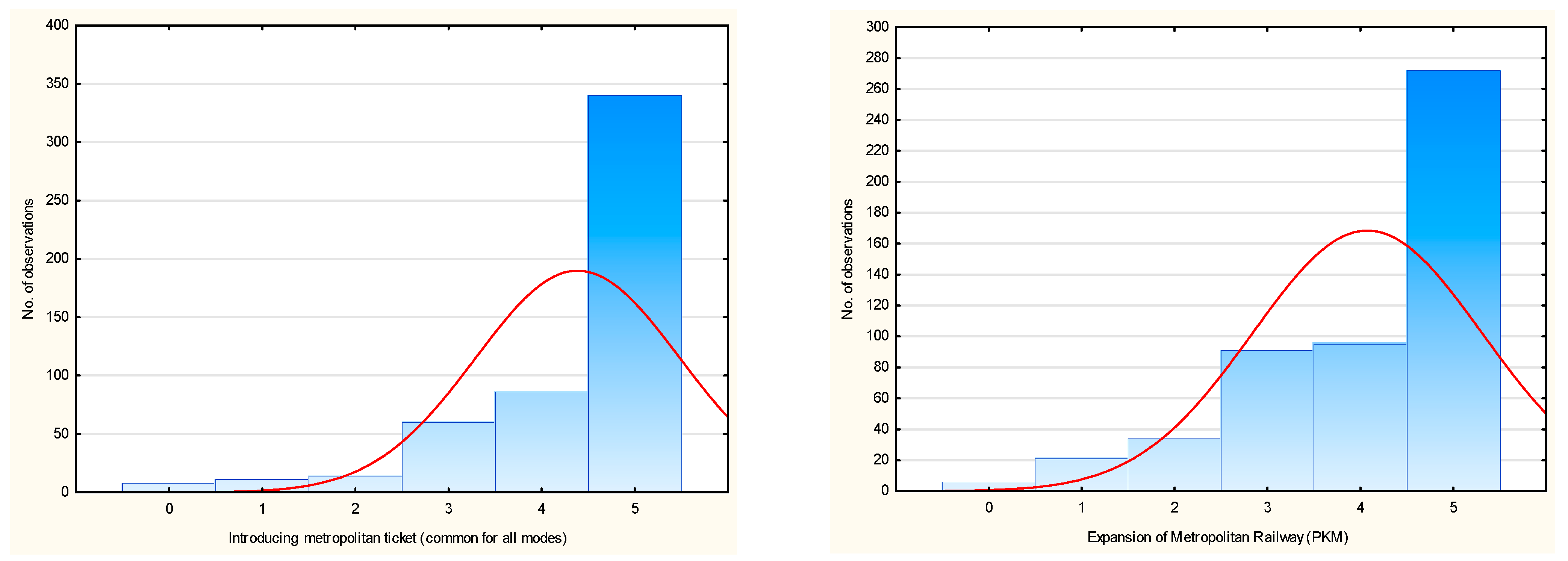
References
- United Nations. World Urbanization Prospects The 2018 Revision; Department of Economic and Social Affairs, Population Division: New York, NY, USA, 2019.
- Wang, J.; Cao, S.J.; Yu, C.W. Development trend and challenges of sustainable urban design in the digital age. Indoor Built Environ. 2021, 30, 3–6. [Google Scholar] [CrossRef]
- Chourabi, H.; Nam, T.; Walker, S.; Gil-Garcia, J.R.; Mellouli, S.; Nahon, K.; Pardo, T.A.; Scholl, H.J. Understanding Smart Cities: An Integrative Framework. In Proceedings of the 2012 45th Hawaii International Conference on System Science (HICSS), Maui, HI, USA, 4–7 January 2012. [Google Scholar]
- Mazzucato, M. Mission-Oriented Research & Innovation in the European Union A Problem-Solving Approach to Fuel Innovation-Led Growth; European Commission: Brussels, Belgium, 2018; pp. 10–25.
- Anand, P.B.; Navio-Marco, J. Governance and economics of smart cities: Opportunities and challenges. Telecommun. Policy 2018, 42, 795–799. [Google Scholar] [CrossRef]
- May, A.D. Urban Transport and Sustainability: The Key Challenges. Int. J. Sustain. Transp. 2013, 7, 483–495. [Google Scholar] [CrossRef]
- Coaffee, J.; Therrien, M.C.; Chelleri, L.; Henstra, D.; Aldrich, D.P.; Mitchell, C.L.; Tsenkova, S.; Rigaud, E. Urban resilience implementation: A policy challenge and research agenda for the 21st century. J. Contingencies Crisis Manag. 2018, 26, 403–410. [Google Scholar] [CrossRef]
- Hörcher, D.; Tirachini, A. A review of public transport economics. Econ. Transp. 2021, 25, 100196. [Google Scholar] [CrossRef]
- Wimbadi, R.W.; Djalante, R.; Mori, A. Urban experiments with public transport for low carbon mobility transitions in cities: A systematic literature review (1990–2020). Sustain. Cities Soc. 2021, 73, 103023. [Google Scholar] [CrossRef]
- Galal, H.; Wimmer, H.; Khurana, A. Smart Mobility. Smart Cities: Mobility Ecosystems for a More Sustainable Future Navigating Converging Social, Economic, and Technological Trends Requires Rethinking Your Ecosystems Strategy, PWCS&B, (2022). Available online: https://www.pwc.com/gx/en/issues/reinventing-the-future/smart-mobility-hub/sustainable-mobility-ecosystems-in-smart-cities.html (accessed on 6 December 2022).
- Bakker, S.; Zuidgeest, M.; de Coninck, H.; Huizenga, C. Transport, Development and Climate Change Mitigation: Towards an Integrated Approach. Transp. Rev. 2014, 34, 335–355. [Google Scholar] [CrossRef]
- Pawłowska, B. Analiza czynników kształtujących popyt na usługi transportowe w Unii Europejskiej. Probl. Transp. I Logistyki 2015, 30, 87–104. [Google Scholar] [CrossRef]
- Korneć, R. System of city transport towards sustainable development. Stud. Miej. 2018, 30, 71–84. [Google Scholar] [CrossRef]
- Ribeiro, P.J.G.; Goncalves, L.A.P.J. Urban resilience: A conceptual framework. Sustain. Cities Soc. 2019, 50, 101625. [Google Scholar] [CrossRef]
- Balakrishnan, S.; Zhang, Z. Developing Priority Index for Managing Utility Disruptions in Urban Areas with Focus on Cascading and Interdependent Effects. Transp. Res. Rec. 2018, 2672, 101–112. [Google Scholar] [CrossRef]
- Mola, M.; Feofilovs, M.; Romagnoli, F. Energy resilience: Research trends at urban, municipal and country levels. Energy Procedia 2018, 147, 104–113. [Google Scholar] [CrossRef]
- Schmaranzer, D.; Braune, R.; Doerner, K.F. Multi-objective simulation optimisation for complex urban mass rapid transit systems. Ann. Oper. Res. 2021, 305, 449–486. [Google Scholar] [CrossRef]
- Mo, B.; Koutsopoulos, H.N.; Zhao, J. Inferring passenger responses to urban rail disruptions using smart card data: A probabilistic framework. Transp. Res. Part E 2022, 159, 102628. [Google Scholar] [CrossRef]
- Maretić, B.; Abramović, B. The Spatial Reorganization of an Integration Transport Point: A Case Study of the City of Šibenik. Transp. Probl. 2021, 16, 15–22. [Google Scholar] [CrossRef]
- Ma, W.L.; Zhao, X. Evaluation research of transfer convergence between inter-city rail transit and urban transport based on AHP and grey clustering method. Adv. Transp. Stud. 2018, 2, 37–48. [Google Scholar]
- Sinkevicius, G.; Ginevicius, R.; Jarasuniene, A. Analysis of clusterisation and networking processes in developing intermodal transportation. Eng. Manag. Prod. Serv. 2016, 8, 63–71. [Google Scholar]
- Koźlak, A. Ograniczenie kongestii transportowej w miastach jako główne wyzwanie dla polityki transportowej. Logistyka 2015, 3, 5386–5394. [Google Scholar]
- Solecka, K. Integration of public transport in polish and EU documents and examples of solutions for integration of public transport in Poland and in the world. Transp. Probl. 2011, 6, 23–34. [Google Scholar]
- Kunicina, N.; Galkina, A.; Zabasta, A.; Patlins, A.; Kondratjevs, K. Traffic Route Modelling and Assignment with Intelligent Transport System. Electr. Control Commun. Eng. 2014, 7, 34–40. [Google Scholar] [CrossRef]
- Boycov, V.; Zivitere, M. GPS Satellite System Integration in Monitoring of Automobile Transport in Latvia. Sci. J. Riga Tech. Univ. Transp. Engineering. Intell. Transp. Syst. 2010, 34, 155–160. [Google Scholar]
- Leng, N.; Corman, F. The role of information availability to passengers in public transport disruptions: An agent-based simulation approach. Transp. Res. Part A 2020, 133, 214–236. [Google Scholar] [CrossRef]
- Bashynska, I. Improving the Tariff Policy of Urban Passenger Transport Based on International Experience. TEM J. 2020, 9, 1588–1596. [Google Scholar] [CrossRef]
- Carlan, V.; Rosca, E.; Rosca, M.A. Urban and peri-urban passenger transport integration through hub-and-spoke-network. Theor. Empir. Res. Urban Manag. 2014, 9, 74–84. [Google Scholar]
- Doina, C. Indicators for the performance and for the effort in transport. Constanta Marit. Univ. Ann. 2013, 18, 261–265. [Google Scholar]
- Bąk, M.; Borkowski, P.; Pawłowska, B. Types of solutions improving passenger transport interconnectivity. Transp. Probl. 2012, 7, 27–63. [Google Scholar]
- Vegah, G.; Wajid, U.; Adebisi, B. Smart-agent system for flexible, personalised transport service. J. Eng. 2016, 12, 456–466. [Google Scholar] [CrossRef]
- König, D.; Eckhardt, J.; Aapaoja, A.; Sochor, J.; Karlsson, M.A. Deliverable 3: Business and Operator Models for MaaS; MAASiFiE Project Funded by CEDR; 2016; pp. 10–16. [Google Scholar]
- Transport Committee. Mobility as a Service, Eight Report of Session 2017-19; UK Parliament: London, UK, 2018; pp. 12–36.
- Koźlak, A.; Pawłowska, B. Mobility-as-a-service for improving mobility in smart cities—A comparative analysis of selected cities. Pr. Nauk. Uniw. Ekon. We Wrocławiu 2019, 63, 31–46. [Google Scholar] [CrossRef]
- Mulley, C.; Nelson, J.D.; Wright, S. Community transport meets mobility as a service: On the road to a new a flexible future. Res. Transp. Econ. 2018, 69, 583–591. [Google Scholar] [CrossRef]
- Lyons, G.; Hammond, P.; Mackay, K. The importance of user perspective in the evolution of MaaS. Transp. Res. Part A 2019, 121, 22–36. [Google Scholar] [CrossRef]
- Li, Y.; Voege, T. Mobility as a Service (MaaS): Challenges of Implementation and Policy Required. J. Transp. Technol. 2017, 7, 95–106. [Google Scholar] [CrossRef]
- Snöeren, A.C.; Balakrishnan, H. An end-to-end approach to host mobility. In MobiCom’00, Proceedings of the 6th Annual International Conference on Mobile Computing and Networking, Massachusetts, Boston, USA, 6–11 August 2000; Association for Computing Machinery: New York, NY, USA, 2000. [Google Scholar]
- Yin, R.K. How to do better case studies: (with illustrations from 20 exemplary case studies). In The SAGE Handbook of Applied Social Research Methods; SAGE Publications, Inc.: Thousand Oaks, CA, USA, 2009; pp. 254–282. [Google Scholar]
- Główny Urząd Statystyczny. Functional Urban Areas. Available online: https://stat.gov.pl/en/regional-statistics/classification-of-territorial-units/union-territorial-typologies-tercet/functional-urban-areas-fua/ (accessed on 25 November 2022).
- OMGGS. Available online: https://www.metropoliagdansk.pl/ (accessed on 25 November 2022).
- Śleszyński, P. Naukowe podstawy i praktyczne problemy klasyfikacji i delimitacji obszarów metropolitalnych. In Instytucjonalne Formy Współdziałania Jednostek Samorządu Terytorialnego na Obszarach Metropolitalnych; Szlachetko, J.H., Gajewski, R., Eds.; Wydawnictwo Uniwersytetu Gdańskiego: Gdańsk, Poland, 2016; pp. 75–85. [Google Scholar]
- GUS. Population. Size and Structure and Vital Statistics in Poland by Territorial Division in 2021; As of 31 December; Statistical Office in Olsztyn: Warsaw, Poland, 2022; pp. 14–23.
- Antal. Investment Potential of Tri-City. Third Edition. 2021. Available online: https://antal.pl/wiedza/raport/potencjal-inwestycyjny-trojmiasta-beas-2021 (accessed on 27 November 2022).
- Połom, M.; Tarkowski, M. The Effect of Pomeranian Metropolitan Railway on Spatial-Functional Structure of Gdańsk (Poland). Stud. Miej. 2018, 30, 39–55. [Google Scholar] [CrossRef]
- Strategia Transportu i Mobilności Obszaru Metropolitalnego Gdańsk-Gdynia-Sopot do Roku 2030. Available online: https://www.metropoliagdansk.pl/upload/files/STIM_ZIT_Strategia-VI%205_2015-10-9_2(1).pdf (accessed on 27 November 2022).
- Statista. Available online: https://www.statista.com/forecasts/1260090/number-shared-mobility-services-users-poland (accessed on 2 December 2022).
- Pandemia a Współdzielona Mobilność. Stan i Perspektywy Polskiego Rynku Mobility-as-a-Service w Obliczu Epidemii COVID-19; Fundacja Digital Poland: Warszawa, Poland, 2020; Available online: https://digitalpoland.prowly.com/114382-pandemia-a-wspoldzielona-mobilnosc-nowy-raport-na-temat-stanu-i-perspektyw-polskiego-rynku-mobility-as-a-service-w-obliczu-epidemii (accessed on 2 December 2022).
- Feng, C.M. New prospects of transportation mobility. IATSS Res. 2014, 38, 22–26. [Google Scholar] [CrossRef]
- Utriainen, R.; Pöllänen, M. Review on Mobility as a Service in scientific publications. Res. Transp. Bus. Manag. 2018, 27, 15–23. [Google Scholar] [CrossRef]
- MaaS Alliance. Available online: https://maas-alliance.eu/2022/11/30/survey-demonstrates-the-interest-in-maas-in-belgium/ (accessed on 8 December 2022).
- van Audenhove, F.J.; Pourbaix, J.; Rominger, G.; Dommergues, E.; Eagar, R.; Carlier, J. The Future of Mobility Post-COVID. Turning the Crisis into an Opportunity to Accelerate Towards More Sustainable, Resilient and Humancentric Urban Mobility Systems, Arthur D Little & UITP. Available online: https://cms.uitp.org/wp/wp-content/uploads/2020/10/2020-ADL-FoM-Lab-UITP_Future-of-Mobility-post-COVID-study.pdf (accessed on 10 December 2022).
- Communication from the Commission to the European Parliament, the Council, the European Economic and Social Committee and the Committee of the Regions, A European Strategy on Cooperative Intelligent Transport Systems, a Milestone towards Cooperative, Connected and Automated Mobility, COM/2016/0766 Final. Available online: https://eur-lex.europa.eu/legal-content/EN/TXT/?uri=CELEX%3A52016DC0766 (accessed on 2 December 2022).
- Transport Trends and Economics 2018–2019, Mobility as a Service; United Nations, UNECE: Geneva, Switzerland, 2020.
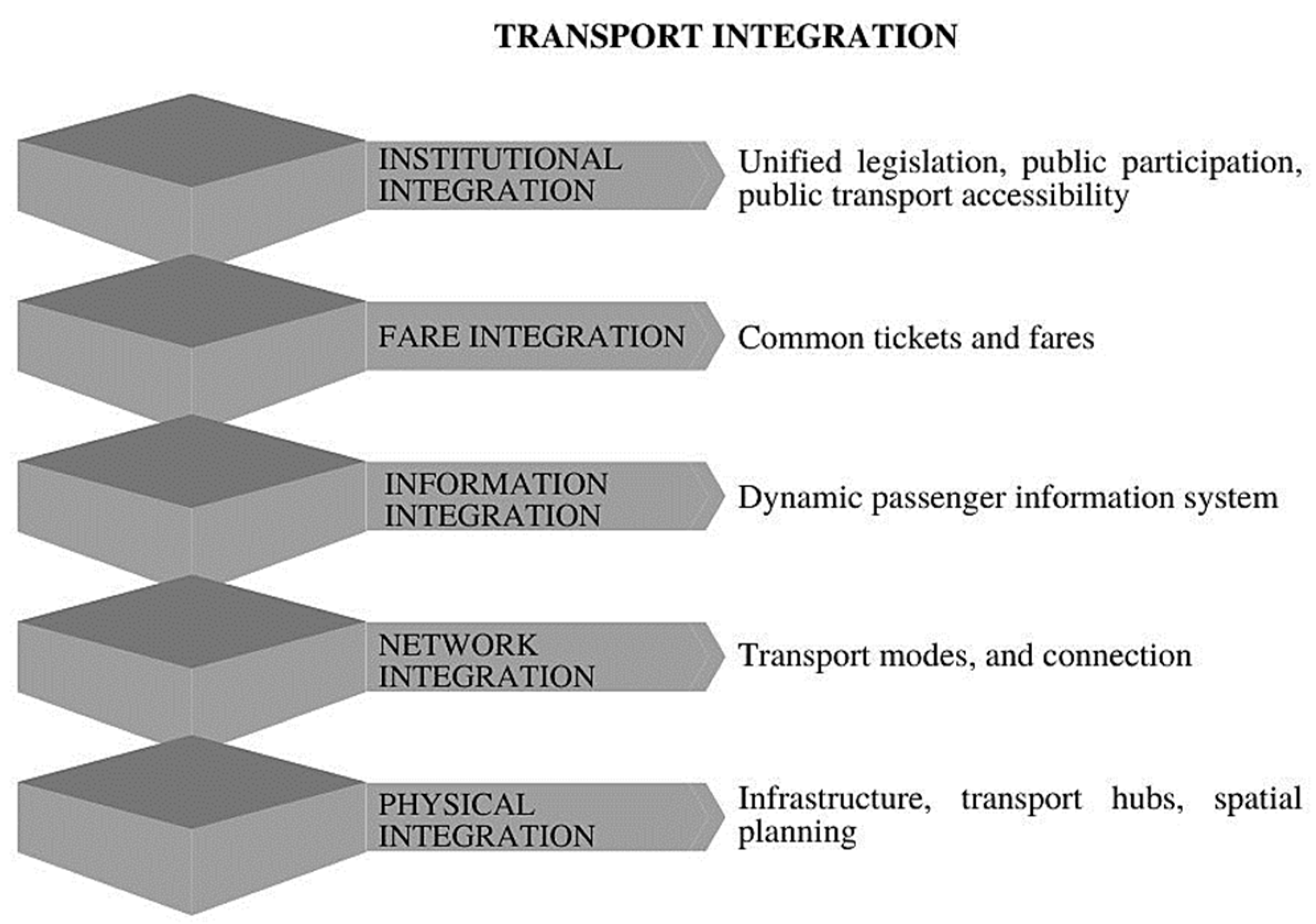
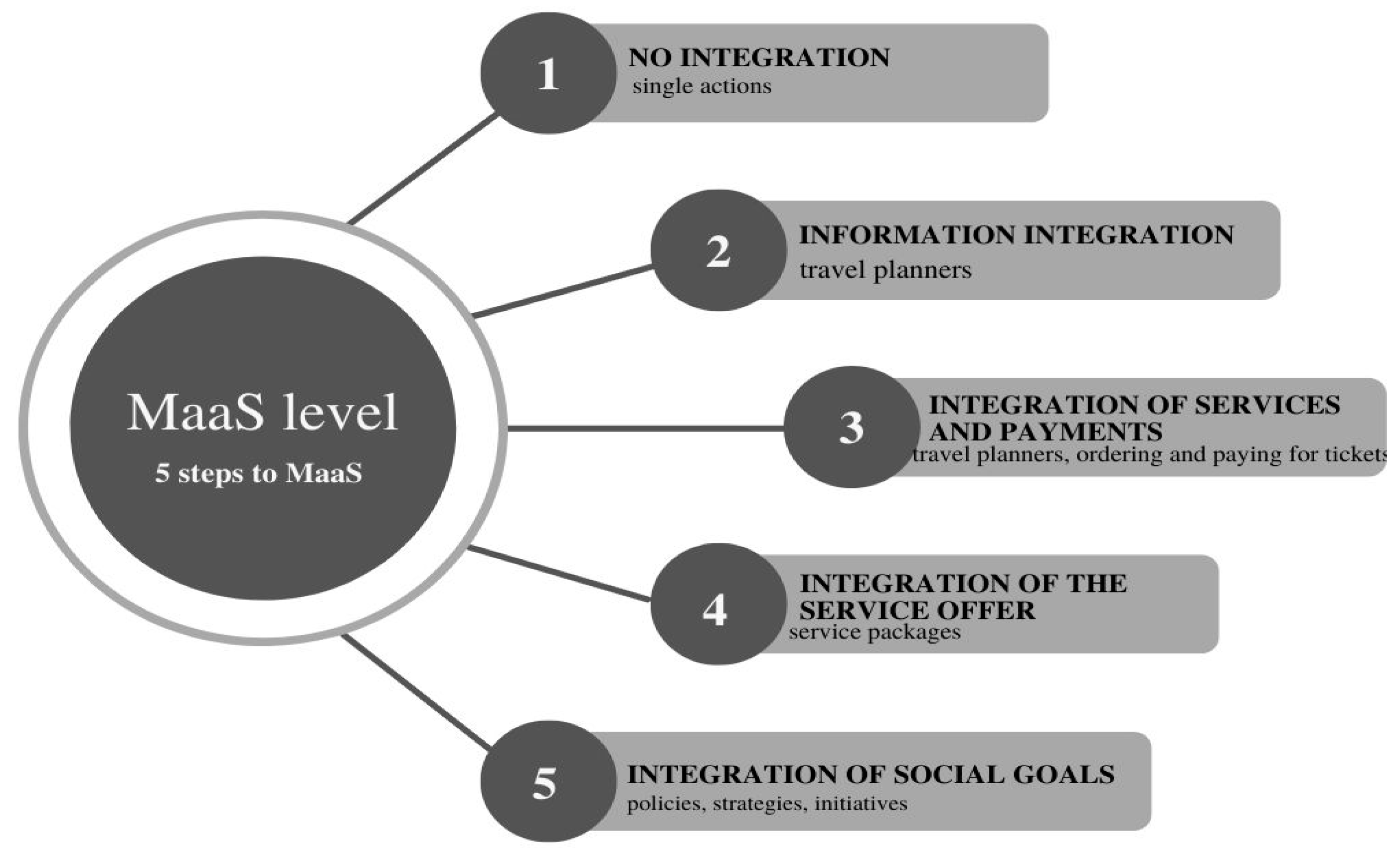
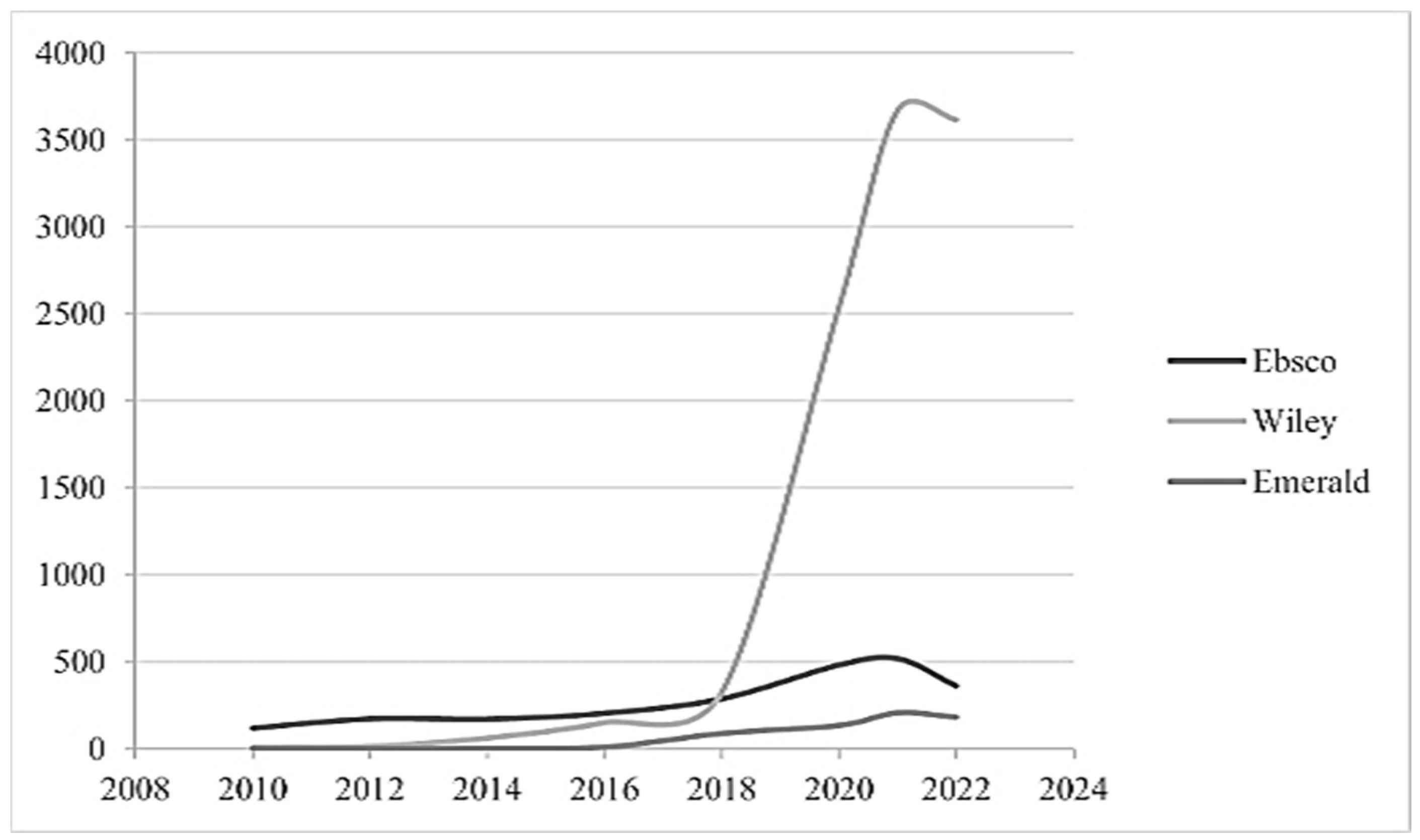
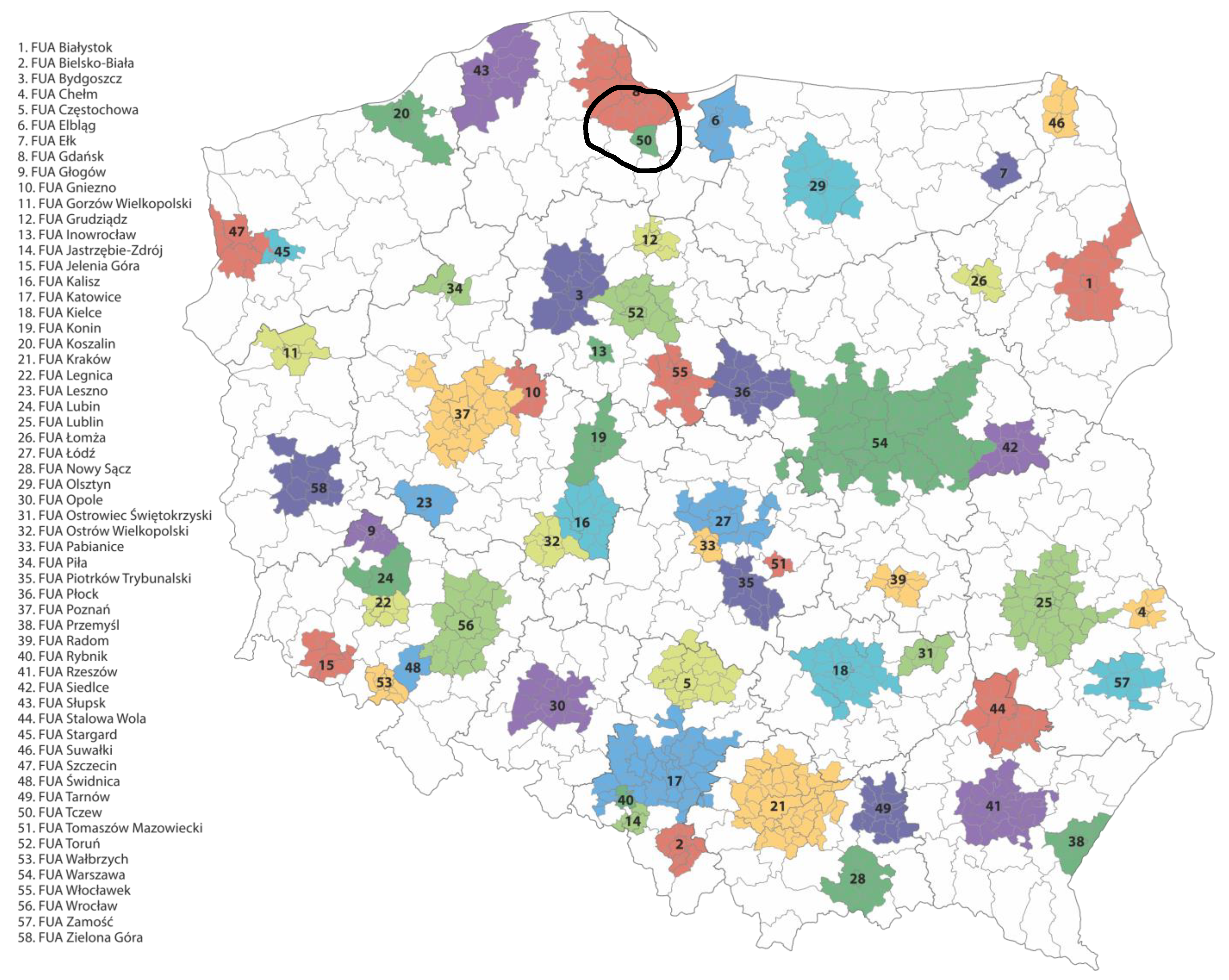

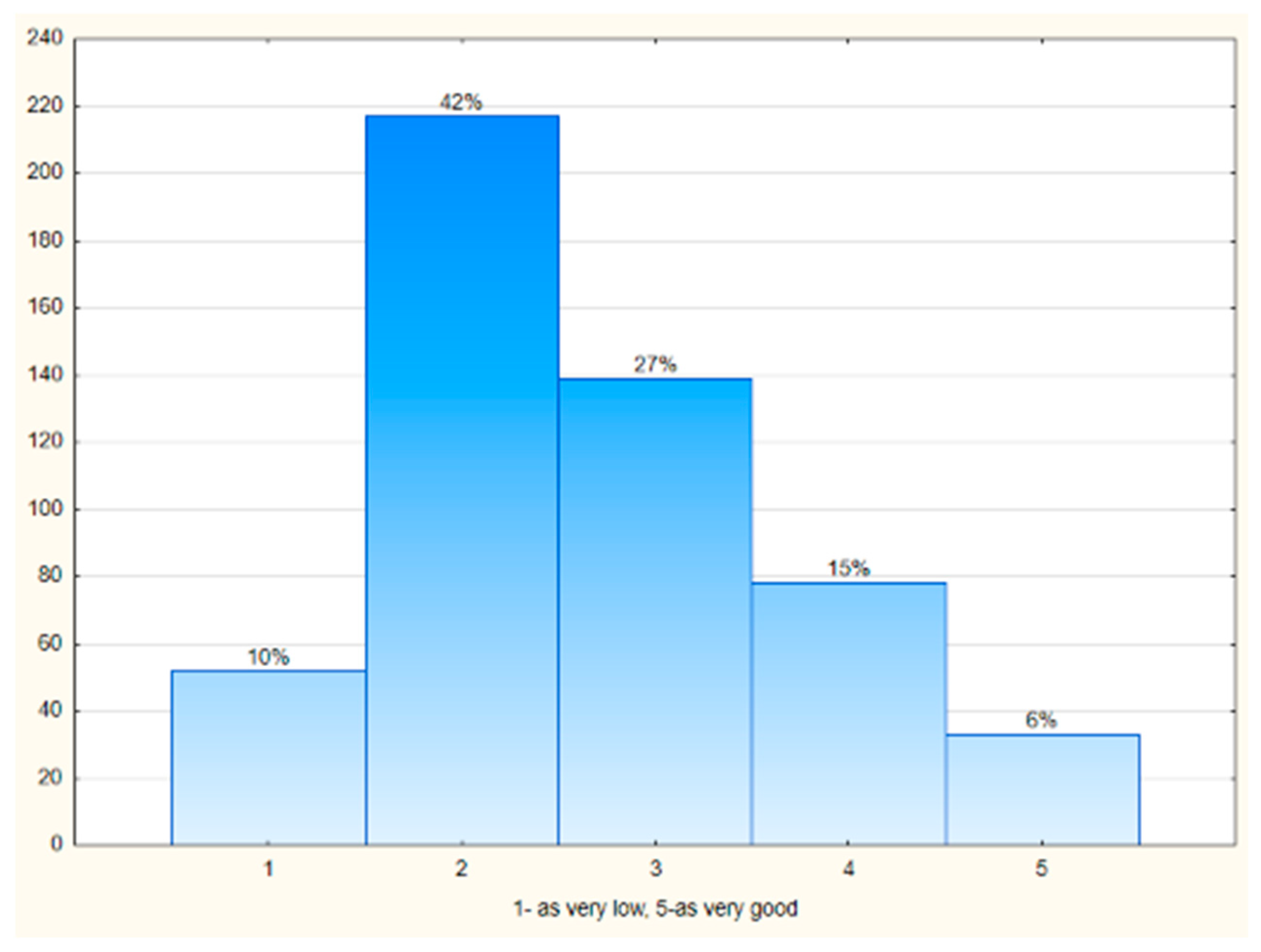
| Key Areas | Sources | Relevance to the Study |
|---|---|---|
| Integration of PT with individual means of transport | [19] | High relevance |
| Functioning of PT in the agglomeration | [20] | High relevance |
| Solutions for increased transport integration | [21,30] | High relevance |
| Identification of MaaS stakeholders in urban transport | [32] | High relevance |
| Defining MaaS and transport integration; identification of potential benefits and barriers to implementation | [33,36] | High relevance |
| An indication of how MaaS fits into the urban transport system | [35] | High relevance |
| Analysis of urban transport solutions for addressing major urban mobility challenges | [6] | Medium relevance |
| Identification of transport system challenges | [6,12] | Medium relevance |
| Analysis of urban transport development strategies and policies towards sustainable mobility | [7] | Medium relevance |
| Analysis of transport demand in the city with a proposal for optimisation | [8,17] | Medium relevance |
| Challenges for urban mobility in EU policy terms | [10] | Low relevance |
| Transport congestion—causes, effects, and counteracting | [22] | Low relevance |
| Define ITS systems and provide examples of such systems | [24] | Low relevance |
| Characteristic | Descriptive Statistic |
|---|---|
| Gender | Female 65.90% |
| Male 32.56% | |
| Other 0.39% | |
| Do not want to indicate 1.15% | |
| Age | 16–24 years old 11.56% |
| 25–49 years old 71.67% | |
| 50–69 years old 14.84% | |
| Over 70 years old 1.93% | |
| Education | Elementary 0.96% |
| Secondary 1.15% | |
| High school 22.92% | |
| Higher education 74.95% | |
| Socio-economic status | Working 78.61% |
| Not working 2.70% | |
| Student 5.20% | |
| Working student 6.55% | |
| Pensioner 4.82% | |
| Working pensioner 2.12% |
| Category | Question | Result |
|---|---|---|
| Travel | Frequency of travel | Every day 63% Few times a week 28% Few times a month 7% Less than few times a month 2% |
| Days when travelling | Only in workdays 14% Only in weekend 1% 7 days a week 84% | |
| Transport mode | Using a car | Going to school or work 42% Go shopping 61% Recreation and entertainment 47% |
| Using car sharing | Recreation and entertainment 6% | |
| Using public transport (bus, tram, trolley) | Going to school or work 44% Go shopping 30% Recreation and entertainment 55% | |
| Using public transport (fast urban rail) | Going to school or work 24% Recreation and entertainment 49% | |
| Using own bike | Going to school or work 19% Go shopping 18% Recreation and entertainment 47% | |
| Using e-scooter | Recreation and entertainment 14% | |
| Going on foot | Going to school or work 30% Go shopping 75% Recreation and entertainment 70% | |
| Multimodality | Using multiple (more than one) transport means to travel | Yes 36% |
| Using MaaS | Level of using MaaS applications | Not using 9% Less than few times a month 32% Few times a month 38% Few times a week 16% Every day 4% |
| The most popular applications | Google Maps 75% Jakdojade.pl 58% Koleo 17% Maps (Mapy) 13% Other 11% |
| Variable/Effect | Assess. | St. Dev. | Wald Stat. | Upper 95.0% | Lower 95.0% | p-Value |
|---|---|---|---|---|---|---|
| Const1 | −1.53523 | 0.836476 | 3.36852 | −3.17469 | 0.10423 | 0.066453 |
| Const2 | 0.87725 | 0.826907 | 1.12547 | −0.74346 | 2.49796 | 0.288744 |
| Const3 | 2.95823 | 0.838634 | 12.44281 | 1.31454 | 4.60192 | 0.000420 |
| Const4 | 4.97320 | 0.866749 | 32.92189 | 3.27440 | 6.67199 | 0.000000 |
| Const5 | 8.19531 | 1.304952 | 39.44047 | 5.63765 | 10.75297 | 0.000000 |
| Frequency of use | 0.26255 | 0.117897 | 4.95919 | 0.03147 | 0.49362 | 0.025952 |
| Days of travelling | −0.24978 | 0.124232 | 4.04231 | −0.49327 | −0.00628 | 0.044373 |
| Lack of own car | −0.76993 | 0.271156 | 8.06243 | −1.30139 | −0.23848 | 0.004519 |
| PT (bus tram (administration) | −0.39593 | 0.190847 | 4.30397 | −0.76999 | −0.02188 | 0.038024 |
| PT (bus tram (recreation) | −0.61904 | 0.183769 | 11.34741 | −0.97922 | −0.25886 | 0.000756 |
| PT (rapid rail) medical visit | −0.79266 | 0.260727 | 9.24281 | −1.30368 | −0.28165 | 0.002364 |
| Own bike (administration) | −0.79683 | 0.289001 | 7.60201 | −1.36326 | −0.23039 | 0.005830 |
| By foot (administration) | −0.57191 | 0.201405 | 8.06323 | −0.96665 | −0.17716 | 0.004517 |
| Gender | −0.32172 | 0.149868 | 4.60838 | −0.61546 | −0.02799 | 0.031816 |
| Age | 0.86334 | 0.157506 | 30.04454 | 0.55463 | 1.17204 | 0.000000 |
| Education | −0.30460 | 0.163142 | 3.48592 | −0.62435 | 0.01516 | 0.061893 |
| Socio-economic status | 0.14375 | 0.068010 | 4.46760 | 0.01045 | 0.27705 | 0.034543 |
| Using car (shopping) | −0.81885 | 0.224433 | 13.31158 | −1.25873 | −0.37896 | 0.000264 |
| Scale | 1.00000 | 0.000000 | 1.00000 | 1.00000 |
Disclaimer/Publisher’s Note: The statements, opinions and data contained in all publications are solely those of the individual author(s) and contributor(s) and not of MDPI and/or the editor(s). MDPI and/or the editor(s) disclaim responsibility for any injury to people or property resulting from any ideas, methods, instructions or products referred to in the content. |
© 2023 by the authors. Licensee MDPI, Basel, Switzerland. This article is an open access article distributed under the terms and conditions of the Creative Commons Attribution (CC BY) license (https://creativecommons.org/licenses/by/4.0/).
Share and Cite
Chmiel, B.; Pawlowska, B.; Szmelter-Jarosz, A. Mobility-as-a-Service as a Catalyst for Urban Transport Integration in Conditions of Uncertainty. Energies 2023, 16, 1828. https://doi.org/10.3390/en16041828
Chmiel B, Pawlowska B, Szmelter-Jarosz A. Mobility-as-a-Service as a Catalyst for Urban Transport Integration in Conditions of Uncertainty. Energies. 2023; 16(4):1828. https://doi.org/10.3390/en16041828
Chicago/Turabian StyleChmiel, Beata, Barbara Pawlowska, and Agnieszka Szmelter-Jarosz. 2023. "Mobility-as-a-Service as a Catalyst for Urban Transport Integration in Conditions of Uncertainty" Energies 16, no. 4: 1828. https://doi.org/10.3390/en16041828
APA StyleChmiel, B., Pawlowska, B., & Szmelter-Jarosz, A. (2023). Mobility-as-a-Service as a Catalyst for Urban Transport Integration in Conditions of Uncertainty. Energies, 16(4), 1828. https://doi.org/10.3390/en16041828








